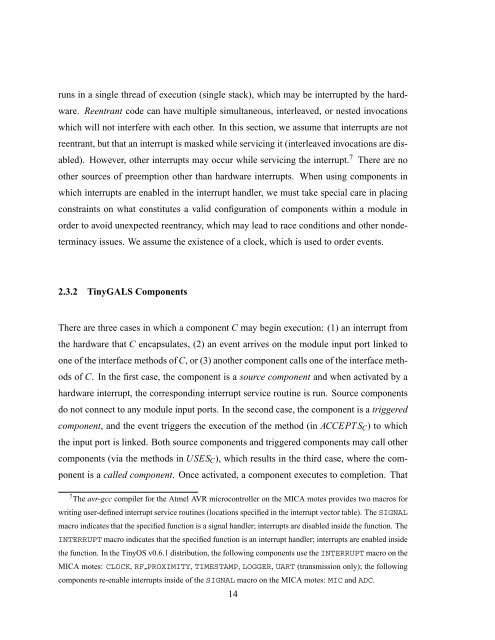Design and Implementation of TinyGALS: A Programming Model for ...
Design and Implementation of TinyGALS: A Programming Model for ...
Design and Implementation of TinyGALS: A Programming Model for ...
You also want an ePaper? Increase the reach of your titles
YUMPU automatically turns print PDFs into web optimized ePapers that Google loves.
uns in a single thread <strong>of</strong> execution (single stack), which may be interrupted by the hard-<br />
ware. Reentrant code can have multiple simultaneous, interleaved, or nested invocations<br />
which will not interfere with each other. In this section, we assume that interrupts are not<br />
reentrant, but that an interrupt is masked while servicing it (interleaved invocations are dis-<br />
abled). However, other interrupts may occur while servicing the interrupt. 7 There are no<br />
other sources <strong>of</strong> preemption other than hardware interrupts. When using components in<br />
which interrupts are enabled in the interrupt h<strong>and</strong>ler, we must take special care in placing<br />
constraints on what constitutes a valid configuration <strong>of</strong> components within a module in<br />
order to avoid unexpected reentrancy, which may lead to race conditions <strong>and</strong> other nonde-<br />
terminacy issues. We assume the existence <strong>of</strong> a clock, which is used to order events.<br />
2.3.2 <strong>TinyGALS</strong> Components<br />
There are three cases in which a component C may begin execution: (1) an interrupt from<br />
the hardware that C encapsulates, (2) an event arrives on the module input port linked to<br />
one <strong>of</strong> the interface methods <strong>of</strong> C, or (3) another component calls one <strong>of</strong> the interface meth-<br />
ods <strong>of</strong> C. In the first case, the component is a source component <strong>and</strong> when activated by a<br />
hardware interrupt, the corresponding interrupt service routine is run. Source components<br />
do not connect to any module input ports. In the second case, the component is a triggered<br />
component, <strong>and</strong> the event triggers the execution <strong>of</strong> the method (in ACCEPT SC) to which<br />
the input port is linked. Both source components <strong>and</strong> triggered components may call other<br />
components (via the methods in USESC), which results in the third case, where the com-<br />
ponent is a called component. Once activated, a component executes to completion. That<br />
7 The avr-gcc compiler <strong>for</strong> the Atmel AVR microcontroller on the MICA motes provides two macros <strong>for</strong><br />
writing user-defined interrupt service routines (locations specified in the interrupt vector table). The SIGNAL<br />
macro indicates that the specified function is a signal h<strong>and</strong>ler; interrupts are disabled inside the function. The<br />
INTERRUPT macro indicates that the specified function is an interrupt h<strong>and</strong>ler; interrupts are enabled inside<br />
the function. In the TinyOS v0.6.1 distribution, the following components use the INTERRUPT macro on the<br />
MICA motes: CLOCK, RF PROXIMITY, TIMESTAMP, LOGGER, UART (transmission only); the following<br />
components re-enable interrupts inside <strong>of</strong> the SIGNAL macro on the MICA motes: MIC <strong>and</strong> ADC.<br />
14
















